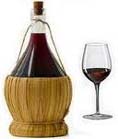
Home...> Articles 7...> Pork And Bacon
|
|
Pork And Bacon
|
|
|
This is a short article about pork and bacon. Of all the animals used in the kitchen, the pig is the most versatile. Pork and bacon joints look and taste entirely different, and methods of cooking cover a wide range of dishes.
About pork and bacon
A pig bred for fresh meat is called a porker. A pig bred for curing (a baconer) is both bred and cut differently. It is split in two for curing, with the head and hind legs removed. Each half is called a "side" and consists of the neck, forehock and back.
Hams and bacon are cured, ham by dry salting and smoking, and bacon by salting in brine and either smoking or leaving unsmoked. Some hams have different cures, notably York and Cumberland which are unsmoked and have a nutty flavour, while Bradenham ham has a treacle cure and is smoked.
Unsmoked (green) bacon is milder in flavour and contains little or no saltpetre. It is therefore especially suitable for use in mixed meat recipes as saltpetre turns meat pink during cooking. Bacon used in mixed meat recipes should be blanched; this will remove the saltpeter.
Pork
Pork can be cooked in many different ways but should always be well done. In the best quality pork the fat is white and firm with a good layer surrounding the meat, which is a rosy pink (paler in very young animals), and marbled with small flecks of fat. These flecks ensure that the cooked flesh will be moist and succulent.
At Christmas time a half or whole leg of salted pork can take the place of a ham, and is very useful as a cut-and-come-again joint.
Crackling
Pork is prized for its crackling. This is the skin, which is scored (slit by the butcher) before roasting. It only "crackles" satisfactorily when the joint comes from the loin and hind quarter.
Sausages
These are made from finely minced lean and fat pork mixed with a proportion of starch (crumbs, rusks or rice), lightly seasoned with spices and herbs and cased in gut.
Cuts of pork
Head: This is classed as offal and used mostly for brawn but may be boned, stuffed and boiled for serving hot or cold.
Spare rib: Taken from top of the neck, this can be roasted or divided and barbecued.
Loin: The best and most expensive piece. Can be roasted whole or boned and stuffed; also divided into chops for grilling or frying. Chump chops are from the end of the loin and, as they are lean, are suitable for a saute or for pot roasting.
Fillet or tenderloin: One of the best cuts, lying under the loin. It is lean and has little waste. Each of the fillets averages about 8-12 oz in weight. They may be split, stuffed and roasted or sauted.
Leg: Large joint, suitable for roasting, which can be halved. Strips from the top of the leg are sometimes known as the fillet half-leg and used for a saute or in pies. Leg joints may also be boned and stuffed.
Salt leg and belly pork: They are traditionally served hot with pease pudding - a good dish for a cold day.
Belly: This is frequently salted. Boil and serve it cold or with other meats in stews or casseroles. When well boiled, with one piece placed on another and then pressed, belly pork makes a good cold dish. Fresh belly pork may be sliced and grilled.
Hand and spring: This is the foreleg and may be boned and divided into small joints for roasting, pot roasting or simply boiling.
Bladebone: Cut from the top of foreleg, usually roasted.
Trotters: They are also classed as offal. Their chief value is to give a good jell when added to a stock or braise.
Page 2 of this Italian Traditional Food article on pork and bacon can be found on the next page.
Page 1 Next >>
- fish
- sauce
- italian
- italian traditional food
- olive oil
- bread
- pasta
- cook
- dish
- food
- vegetables
- dessert
- recipes
- cooking
- meal
- traditional
- herbs
- cheese
- recipe
- meat

Copyright © 2009 - . All Rights Reserved Worldwide. Italian Traditional Food
You may not reprint articles from this website without the written permission of the site owner.
Disclaimer: Articles on this Website are provided for information purposes only. Italiantraditionalfood.com does not accept any responsibility or liability for the use or misuse of the article content on this site or reliance by any person on the site's contents.
|

Latest Articles
|
|
COMMENTS 'Great recipes and a great site...' 'At long last, a recipe site that delivers good basic food...' 'Tasty and easy to make recipes. What more can you ask for?...' 'Please keep on providing these rustic recipes as I enjoyed them very much....' 'Not only some great recipes but also some great articles. Thanks." 'What a good idea to provide these recipes. Keep up the good work.' 'Lots of very intresting articles on all aspects of the Italian lifestyle...' 'Wishing you every success with your great new recipe site.." 'Good to see some authentic Italian rustic recipes..." 'The step-by-step recipes are very easy to follow. Thank you.' 'It is so much easier to follow the Italian food recipes thanks to the step by step photos." '...thank you for publishing this selection of rural dishes. They are fast becoming part of my staple diet.' |
Copyright © 2009 - . All Rights Reserved Worldwide. Italian Traditional Food
 Digg
Digg Stumbleupon
Stumbleupon Google Bookmarks
Google Bookmarks Delicious
Delicious Twitter
Twitter Facebook
Facebook Yahoo My Web
Yahoo My Web Reddit
Reddit